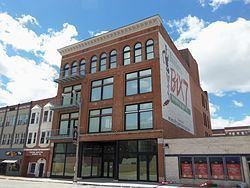Area less than one acre Architectural style Early Commercial NRHP Reference # 83002491 Added to NRHP 7 July 1983 | Built 1897 MPS Davenport MRA Opened 1897 | |
 | ||
Location 324 Brady StreetDavenport, Iowa Similar Iowa Reform Building, JHC Petersen's Sons' Store, Hose Station No 1, Dillon Memorial, School Number 6 | ||
The Renwick Building is located in downtown Davenport, Iowa, United States. It has been listed on the National Register of Historic Places since 1983, and on the Davenport Register of Historic Properties since 2000. It is known locally for the large painted sign on the north side of the building depicting the Bix 7 Road Race.
Contents
History
The building was built by its namesake William Renwick, who was a prosperous Davenport industrialist in the late 19th and early 20th centuries. Two of his houses are also on the National Register of Historic Places, the Renwick House on Brady Street and the Renwick Mansion, which is a contributing property in the St. Katherine's Historic District. The building combined retail and warehouse space and housed various furniture stores over the years. The storefront was modernized in the 1930s. Henry Huebotter's Davenport Furniture was the first business to occupy the structure after it was built. It was followed by Drake Furniture and Carpet, Iowa Furniture & Carpet Co. and Freeman-Glickman. Matthew’s Office Supply occupied the building until 2005. The building sat empty until 2012 when Restoration St. Louis, who also renovated the Forrest Block and the Hotel Blackhawk, began a $4.5 million renovation of the building. The upper floors house 18 loft-style apartments and commercial space on the main floor. In 2015 the independent music website Daytrotter moved into the commercial space.
Architecture
The Renwick Building is a steel frame and brick commercial building. The four-story building reflects the Chicago Commercial Style. The brick façade acts as the building’s skin around the steel frame, which supports the structure. This technology allowed a greater expanse of windows, which are found in this building. Decorative elements are found at the top of the building. Round arch windows in a tri-partite configuration line the fourth floor on the facade, and the building is topped with a heavy ornate cornice.
